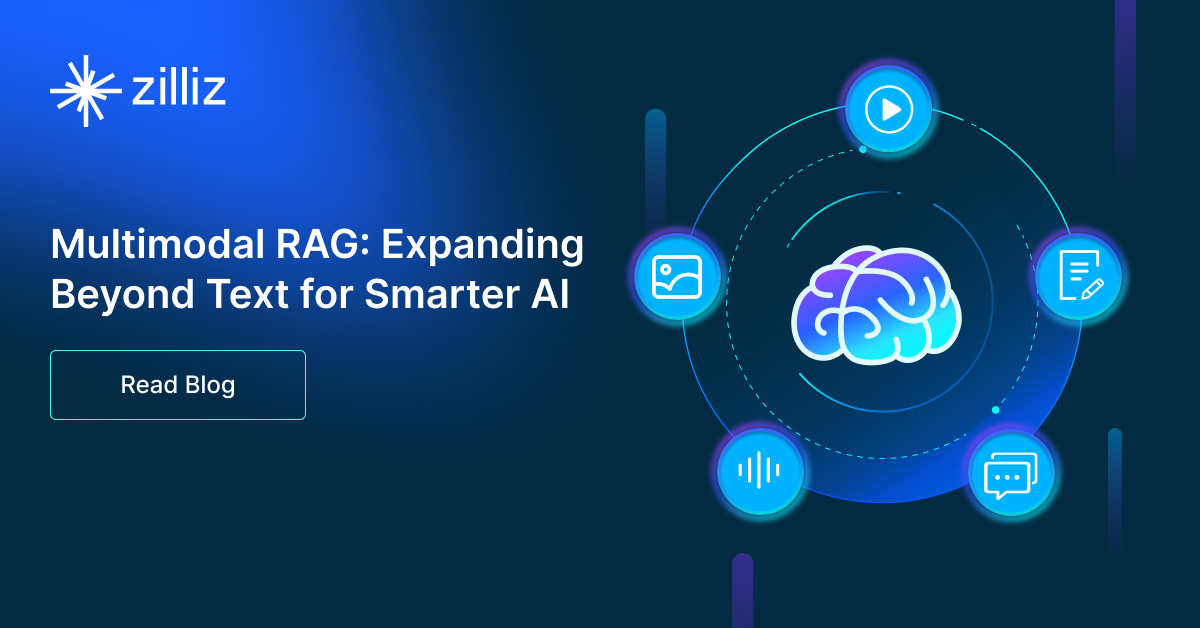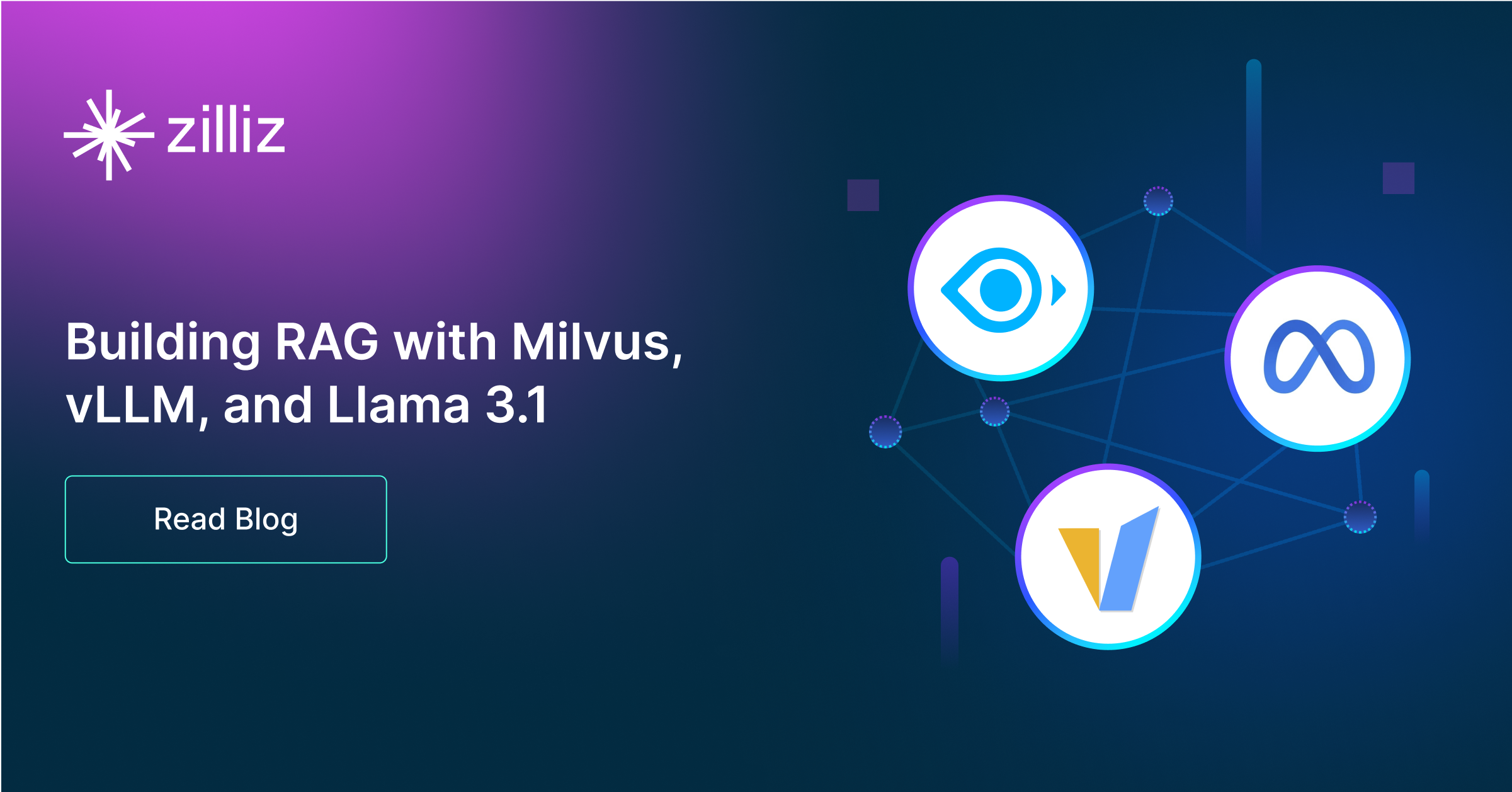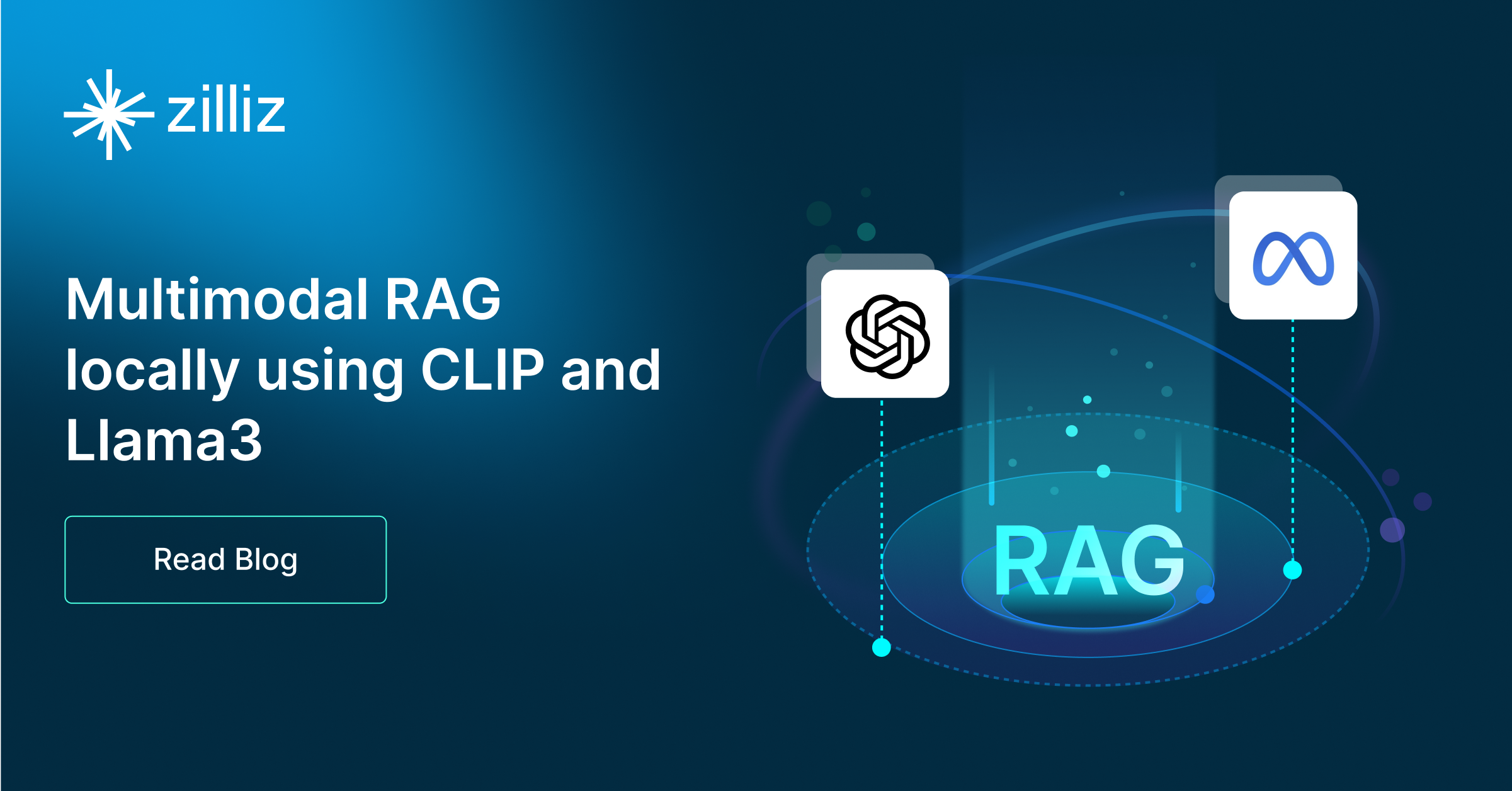Build RAG Chatbot with LangChain, LangChain vector store, AWS Bedrock Claude 3.7 Sonnet, and HuggingFace all-mpnet-base-v2
Introduction to RAG
Retrieval-Augmented Generation (RAG) is a game-changer for GenAI applications, especially in conversational AI. It combines the power of pre-trained large language models (LLMs) like OpenAI’s GPT with external knowledge sources stored in vector databases such as Milvus and Zilliz Cloud, allowing for more accurate, contextually relevant, and up-to-date response generation. A RAG pipeline usually consists of four basic components: a vector database, an embedding model, an LLM, and a framework.
Key Components We'll Use for This RAG Chatbot
This tutorial shows you how to build a simple RAG chatbot in Python using the following components:
- LangChain: An open-source framework that helps you orchestrate the interaction between LLMs, vector stores, embedding models, etc, making it easier to integrate a RAG pipeline.
- LangChain in-memory vector store: an in-memory, ephemeral vector store that stores embeddings in-memory and does an exact, linear search for the most similar embeddings. The default similarity metric is cosine similarity, but can be changed to any of the similarity metrics supported by ml-distance. It is intended for demos and does not yet support ids or deletion. (If you want a much more scalable solution for your apps or even enterprise projects, we recommend using Zilliz Cloud, which is a fully managed vector database service built on the open-source Milvusand offers a free tier supporting up to 1 million vectors.)
- AWS Bedrock Claude 3.7 Sonnet: AWS Bedrock Claude 3.7 Sonnet: Built on Anthropic's Claude 3.7 Sonnet, AWS Bedrock integrates Claude's capabilities into AWS services, enabling seamless AI model deployment across industries. It offers scalable, high-performance natural language processing for enterprises, enhancing tasks like content creation, chatbots, and language-based AI solutions while leveraging AWS’s cloud infrastructure for ease of integration and scalability.
- HuggingFace all-mpnet-base-v2: This model is a variant of MPNet designed for general-purpose NLP tasks, offering superior performance in sentence embeddings and semantic similarity. It excels in understanding contextual nuances, making it ideal for search, recommendation systems, and any application requiring robust textual comprehension and matching capabilities.
By the end of this tutorial, you’ll have a functional chatbot capable of answering questions based on a custom knowledge base.
Note: Since we may use proprietary models in our tutorials, make sure you have the required API key beforehand.
Step 1: Install and Set Up LangChain
%pip install --quiet --upgrade langchain-text-splitters langchain-community langgraph
Step 2: Install and Set Up AWS Bedrock Claude 3.7 Sonnet
pip install -qU "langchain[aws]"
# Ensure your AWS credentials are configured
from langchain.chat_models import init_chat_model
llm = init_chat_model("anthropic.claude-3-7-sonnet-20250219-v1:0", model_provider="bedrock_converse")
Step 3: Install and Set Up HuggingFace all-mpnet-base-v2
pip install -qU langchain-huggingface
from langchain_huggingface import HuggingFaceEmbeddings
embeddings = HuggingFaceEmbeddings(model_name="sentence-transformers/all-mpnet-base-v2")
Step 4: Install and Set Up LangChain vector store
pip install -qU langchain-core
from langchain_core.vectorstores import InMemoryVectorStore
vector_store = InMemoryVectorStore(embeddings)
Step 5: Build a RAG Chatbot
Now that you’ve set up all components, let’s start to build a simple chatbot. We’ll use the Milvus introduction doc as a private knowledge base. You can replace it with your own dataset to customize your RAG chatbot.
import bs4
from langchain import hub
from langchain_community.document_loaders import WebBaseLoader
from langchain_core.documents import Document
from langchain_text_splitters import RecursiveCharacterTextSplitter
from langgraph.graph import START, StateGraph
from typing_extensions import List, TypedDict
# Load and chunk contents of the blog
loader = WebBaseLoader(
web_paths=("https://milvus.io/docs/overview.md",),
bs_kwargs=dict(
parse_only=bs4.SoupStrainer(
class_=("doc-style doc-post-content")
)
),
)
docs = loader.load()
text_splitter = RecursiveCharacterTextSplitter(chunk_size=1000, chunk_overlap=200)
all_splits = text_splitter.split_documents(docs)
# Index chunks
_ = vector_store.add_documents(documents=all_splits)
# Define prompt for question-answering
prompt = hub.pull("rlm/rag-prompt")
# Define state for application
class State(TypedDict):
question: str
context: List[Document]
answer: str
# Define application steps
def retrieve(state: State):
retrieved_docs = vector_store.similarity_search(state["question"])
return {"context": retrieved_docs}
def generate(state: State):
docs_content = "\n\n".join(doc.page_content for doc in state["context"])
messages = prompt.invoke({"question": state["question"], "context": docs_content})
response = llm.invoke(messages)
return {"answer": response.content}
# Compile application and test
graph_builder = StateGraph(State).add_sequence([retrieve, generate])
graph_builder.add_edge(START, "retrieve")
graph = graph_builder.compile()
Test the Chatbot
Yeah! You've built your own chatbot. Let's ask the chatbot a question.
response = graph.invoke({"question": "What data types does Milvus support?"})
print(response["answer"])
Example Output
Milvus supports various data types including sparse vectors, binary vectors, JSON, and arrays. Additionally, it handles common numerical and character types, making it versatile for different data modeling needs. This allows users to manage unstructured or multi-modal data efficiently.
Optimization Tips
As you build your RAG system, optimization is key to ensuring peak performance and efficiency. While setting up the components is an essential first step, fine-tuning each one will help you create a solution that works even better and scales seamlessly. In this section, we’ll share some practical tips for optimizing all these components, giving you the edge to build smarter, faster, and more responsive RAG applications.
LangChain optimization tips
To optimize LangChain, focus on minimizing redundant operations in your workflow by structuring your chains and agents efficiently. Use caching to avoid repeated computations, speeding up your system, and experiment with modular design to ensure that components like models or databases can be easily swapped out. This will provide both flexibility and efficiency, allowing you to quickly scale your system without unnecessary delays or complications.
LangChain in-memory vector store optimization tips
LangChain in-memory vector store is just an ephemeral vector store that stores embeddings in-memory and does an exact, linear search for the most similar embeddings. It has very limited features and is only intended for demos. If you plan to build a functional or even production-level solution, we recommend using Zilliz Cloud, which is a fully managed vector database service built on the open-source Milvus and offers a free tier supporting up to 1 million vectors.)
AWS Bedrock Claude 3.7 Sonnet Optimization Tips
When integrating AWS Bedrock Claude 3.7 Sonnet in a RAG setup, optimize the retrieval pipeline by leveraging AWS’s scalable infrastructure for high-performance searches. Index documents based on relevance to ensure fast and accurate retrievals, and consider using AWS services like Lambda for dynamic scaling. Fine-tune Claude 3.7 Sonnet on specific industry or application data to enhance contextual relevance. Minimize costs and latency by adjusting the batch sizes for queries and optimizing the use of cloud-based storage solutions. Ensure that model hyperparameters, such as temperature and beam width, are fine-tuned to maintain both creativity and accuracy in generated responses.
HuggingFace all-mpnet-base-v2 optimization tips
HuggingFace all-mpnet-base-v2 is a robust and efficient embedding model that excels in semantic understanding for RAG tasks. Optimize retrieval by reducing text noise before embedding, ensuring that only meaningful content is processed. Use approximate nearest neighbor (ANN) search with FAISS or a similar framework to accelerate query resolution without compromising quality. Implement dimensionality reduction techniques to save memory and reduce computational overhead. Leverage caching strategies for frequently queried text embeddings to minimize API calls and improve latency. Fine-tune the embedding model on task-specific data to improve accuracy and relevance in your search results. When scaling, use parallel processing for large datasets and batch embedding operations to optimize throughput.
By implementing these tips across your components, you'll be able to enhance the performance and functionality of your RAG system, ensuring it’s optimized for both speed and accuracy. Keep testing, iterating, and refining your setup to stay ahead in the ever-evolving world of AI development.
RAG Cost Calculator: A Free Tool to Calculate Your Cost in Seconds
Estimating the cost of a Retrieval-Augmented Generation (RAG) pipeline involves analyzing expenses across vector storage, compute resources, and API usage. Key cost drivers include vector database queries, embedding generation, and LLM inference.
RAG Cost Calculator is a free tool that quickly estimates the cost of building a RAG pipeline, including chunking, embedding, vector storage/search, and LLM generation. It also helps you identify cost-saving opportunities and achieve up to 10x cost reduction on vector databases with the serverless option.
 Calculate your RAG cost
Calculate your RAG cost
What Have You Learned?
By diving into this tutorial, you’ve unlocked the power of combining cutting-edge tools to build a robust RAG system from scratch! You learned how LangChain acts as the glue that ties everything together, orchestrating the flow of data between your vector database, embedding model, and LLM. The LangChain vector store became your go-to for lightning-fast semantic search, efficiently storing and retrieving embeddings generated by Hugging Face’s all-mpnet-base-v2 model—a powerhouse for converting text into meaningful numerical representations. Then came AWS Bedrock’s Claude 3 Sonnet, which transformed those retrieved snippets into human-like, context-aware responses, showcasing how seamlessly modern LLMs can interpret and generate natural language. Along the way, you saw how these components harmonize: embeddings breathe structure into unstructured data, vector databases enable smart retrieval, and LLMs turn raw information into actionable insights. You even picked up pro tips for optimizing performance, like tweaking chunk sizes and refining prompts, and discovered tools like the free RAG cost calculator to balance efficiency and budget.
Now, armed with this knowledge, you’re ready to create RAG applications that feel almost magical! Whether you’re building chatbots, research assistants, or custom knowledge bases, you’ve got the toolkit to make data work smarter, not harder. Experiment with different models, fine-tune your retrieval strategies, and let your creativity run wild. The future of intelligent applications is in your hands—so go break boundaries, iterate fearlessly, and share what you build. The world needs your innovations, and there’s no better time to start than right now. Happy coding! 🚀
Further Resources
🌟 In addition to this RAG tutorial, unleash your full potential with these incredible resources to level up your RAG skills.
- How to Build a Multimodal RAG | Documentation
- How to Enhance the Performance of Your RAG Pipeline
- Graph RAG with Milvus | Documentation
- How to Evaluate RAG Applications - Zilliz Learn
- Generative AI Resource Hub | Zilliz
We'd Love to Hear What You Think!
We’d love to hear your thoughts! 🌟 Leave your questions or comments below or join our vibrant Milvus Discord community to share your experiences, ask questions, or connect with thousands of AI enthusiasts. Your journey matters to us!
If you like this tutorial, show your support by giving our Milvus GitHub repo a star ⭐—it means the world to us and inspires us to keep creating! 💖
- Introduction to RAG
- Key Components We'll Use for This RAG Chatbot
- Step 1: Install and Set Up LangChain
- Step 2: Install and Set Up AWS Bedrock Claude 3.7 Sonnet
- Step 3: Install and Set Up HuggingFace all-mpnet-base-v2
- Step 4: Install and Set Up LangChain vector store
- Step 5: Build a RAG Chatbot
- Optimization Tips
- RAG Cost Calculator: A Free Tool to Calculate Your Cost in Seconds
- What Have You Learned?
- Further Resources
- We'd Love to Hear What You Think!
Content
Vector Database at Scale
Zilliz Cloud is a fully-managed vector database built for scale, perfect for your RAG apps.
Try Zilliz Cloud for Free


